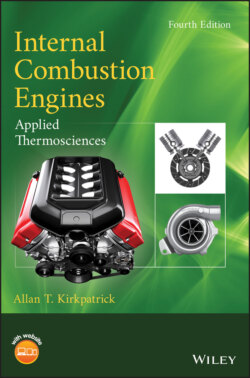Читать книгу Internal Combustion Engines - Allan T. Kirkpatrick - Страница 46
2.2 Gas Cycle Energy Addition
ОглавлениеIn performing an ideal gas cycle computation, the energy addition (kJ) is required. There are a number of methods used to determine , depending on what initial information is available. If , the energy addition per unit mass of fuel–air mixture (kJ/) is known, then
(2.1)
where is the mass of the fuel–air mixture in the cylinder. If the fuel mass in the cylinder is known, can be computed from the heat of combustion, (kJ/), of a fuel:
(2.2)
Finally, the energy addition can be found by analysis of the fuel–air mixture in the cylinder at bottom dead center (bdc). The mass of fuel and air in the cylinder is
(2.3)
and the air–fuel ratio is
(2.4)
Solving for ,
(2.5)
The mass of the fuel–air mixture can be determined from the ideal gas law,
(2.6)
where is the air–fuel mixture gas constant.
(2.7)
Upon substitution of Equations (2.5) and (2.6), the energy addition can be expressed as
(2.8)
and in nondimensional form,
(2.9)
Values of the heat of combustion, (MJ/) and the stoichiometric air–fuel ratio are given in Table 2.1 for some representative fuels that are widely used in internal combustion engines. The effect of the residual fraction on the determination of the energy addition is included in the the analysis of intake and exhaust strokes later in this chapter.
Table 2.1 Fuel Properties
| Formula | Name | ||
| (MJ/kg) | |||
| CH4 (g) | Methane | 50.01 | 17.12 |
| C8H18 (l) | Octane | 44.30 | 15.03 |
| C14.4H24.9 (l) | Diesel | 42.94 | 14.30 |
| C2H6O (l) | Ethanol | 26.82 | 8.94 |
